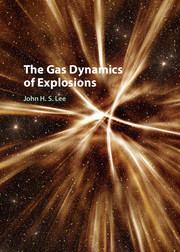Crossref Citations
This Book has been
cited by the following publications. This list is generated based on data provided by Crossref.
Polandov, Yuri
Kukin, Denis
Jemioło, S.
Zbiciak, A.
Mitew-Czajewska, M.
Krzemiński, M.
and
Gajewski, M.
2017.
The results of the first periodical testing vent-panels (VP).
MATEC Web of Conferences,
Vol. 117,
Issue. ,
p.
00139.
Prunty, Seán
2019.
Introduction to Simple Shock Waves in Air.
p.
35.
Prunty, Seán
2019.
Introduction to Simple Shock Waves in Air.
p.
1.
Prunty, Seán
2019.
Introduction to Simple Shock Waves in Air.
p.
81.
Prunty, Seán
2019.
Introduction to Simple Shock Waves in Air.
p.
157.
Mével, R.
and
He, Y. Z.
2020.
Effect of oxygen atom precursors addition on LTC-affected detonation in $${\hbox {DME}}{-}{\hbox {O}}_{2}{-}{\hbox {CO}}_{2}$$ mixtures.
Shock Waves,
Vol. 30,
Issue. 7-8,
p.
799.
Prunty, Seán
2021.
Introduction to Simple Shock Waves in Air.
p.
89.
Prunty, Seán
2021.
Introduction to Simple Shock Waves in Air.
p.
1.
Prunty, Seán
2021.
Introduction to Simple Shock Waves in Air.
p.
43.
Ströer, Philip
Krimmelbein, Normann
Krumbein, Andreas
and
Grabe, Cornelia
2021.
Stability-Based Transition Transport Modeling for Unstructured Computational Fluid Dynamics at Transonic Conditions.
AIAA Journal,
Vol. 59,
Issue. 9,
p.
3585.
Marcantoni, Luis Gutierrez
Elaskar, Sergio
and
Tamagno, Jose
2022.
Explosiones y detonaciones su simulación numérica, sus similitudes y diferencias.
p.
1.
Reuter, C. B.
Ombrello, T. M.
and
Tuttle, S. G.
2022.
Can ozonolysis reactions influence detonations?.
Shock Waves,
Vol. 32,
Issue. 4,
p.
363.
Foust III, Henry Clyde
2022.
Thermodynamics, Gas Dynamics, and Combustion.
p.
363.
Anand, R. K.
2022.
On the shock dynamics of weak converging shock waves in solid materials.
Ricerche di Matematica,
Vol. 71,
Issue. 2,
p.
511.
Venkatachari, Balaji Shankar
Paredes, Pedro
Choudhari, Meelan M.
Li, Fei
and
Chang, Chau-Lyan
2022.
Transition Analysis for the CRM-NLF Wind Tunnel Configuration using Transport Equation Models and Linear Stability Correlations.



